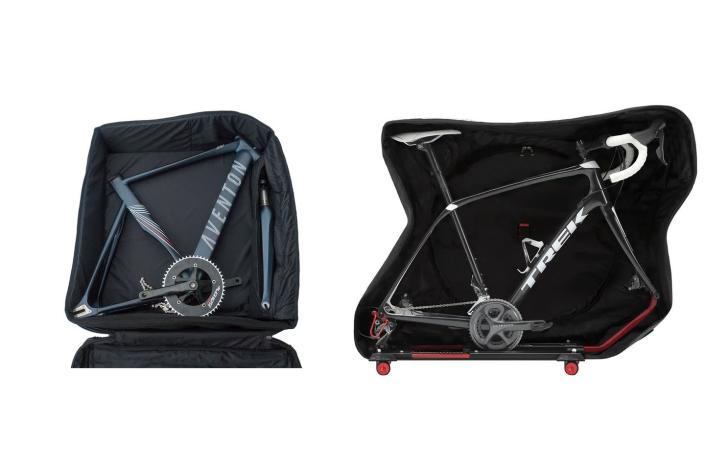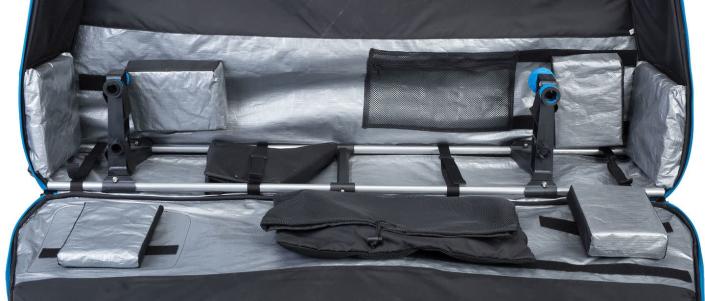The Best Cases for Traveling With Your Bike
[ad_1]

Whether you’re planning to travel across the country or across the globe, a sturdy bike travel case or bag is a worthy investment. Your bike will be better protected—and you’ll have more peace of mind—than it will if you stuff it into a cardboard box and hope for the best. Here’s what you need to know.
Hardshell versus Softshell
Hardshell cases provide the highest level of protection against impacts, but they also weigh more, which can lead to even higher luggage fees. Hard cases also don’t break down, so they take up more room in a hotel room or rental car when not in use.

Softshell cases have come a long way in recent years, and some offer nearly the same level of protection as hard-shell models. Softshell cases are usually lighter than hard-shell cases, and fold or roll down for easier storage.
Join Bicycling All Access for more gear advice
Protection
Hard-shell cases usually rely on a rigid, outer shell—made from a type of plastic—for their protection. Most softshell cases are constructed from durable nylon and rely on padding to protect your bike.

Some softshell cases have a rigid internal frame that provides structure and protects the bike from crushing forces. There are also hybrid cases, which have a fabric exterior lined with foam and plastic sheets.

Both types of cases often include additional padding for the frame, as well as straps to hold the frame and wheels in place.
Size and Weight
Pay attention to the size and weight of a bike case, particularly as it relates to the weight of the bike you plan to transport. Most airlines have a 50-pound weight limit before incurring an overweight fee. You need to factor in the weight of the case, the bike, and other items you’re considering throwing in there before selecting a case.
Hard-shell cases are more protective, but weigh more, leaving less for packing materials, bike, and gear. Softshell cases are lighter, which means you can pack a heavier bike without exceeding the limit but may offer less protection for your gear. The weight difference can be extreme: Thule’s Roundtrip Transition is made of ABS plastic and extremely rugged but weighs 38 pounds, while Orucase’s soft-sided Sub62 weighs just 13 pounds.
Most airlines have a dimensional limit of 62 linear inches—calculated by adding together the total length, width, and height of the bag. If an item of luggage is larger, it can incur an oversize-bag fee. Orucase’s Sub62 is smaller than 62 linear inches, so it should avoid an oversize fee, while Thule’s armored RoundTrip Transition measures over 106 linear inches and is almost certain to cost you extra.
Packing Tips and Tricks
Before choosing a case, have an idea of how much bike disassembly/assembly you’re comfortable with.
Cases like Scicon’s AeroComfort require very little wrenching to pack and unpack a bike but are larger and likely to incur a bike or oversize fee. A smaller and lighter case like Orucase’s Sub62 is much less likely to incur an oversize or overweight charge, but packing the bike into this case requires removal of both wheels, the bar and stem, rear derailleur, pedals, seatpost, and fork.

If you want to use additional padding to protect your bike during transit, consider using your cycling apparel, since it has to make the trip with you anyway. You can also use pipe insulation, which is inexpensive and can be purchased at your local home-supply store. Always be sure you also have all the tools you need to get your bike back up and running at your destination.
How We Picked
Every case on this list has been thoroughly evaluated and vetted by our team of test editors. We also consulted product managers and designers, athletes, and used our own travel experience with these cases to determine the best options. We evaluated them on performance, price, protection, weight, size, and how much bike disassembly is required to come up with a list of cases to serve the needs of anyone traveling with bikes.
Here are nine of our favorite bike travel bags and cases you can buy right now.
Most Stealthy: Orucase Sub62

Looking to sneak your road bike through security and escape extra baggage fees? If so, the Sub62 is the ticket.
The ultra-compact bike backpack fits most road frames and breakaway-style travel bikes. Though it’s soft-sided, the Sub62 uses integrated plastic panels with energy-absorbing foam to armor it against impacts.
Least Wrenching: Scicon AeroComfort 3.0 TSA

Scicon’s AeroComfort 3.0 TSA blends the low weight of a soft-sided bike bag with a rigid frame to protect your prized ride from surly baggage handlers.
This travel bag is designed specifically for drop-bar bikes and requires minimal disassembly. The wheels stow in dedicated pockets on the sides and, best of all, there’s no need to remove the handlebar. The adjustable chassis holds your frame in place by the axles—either quick-release or 12mm thru-axles.
The four-wheeled design makes it easy to maneuver through crowded airports, and the compact design keeps it within many airlines’ standard luggage dimensions, which may help you skip oversize baggage fees.
Best For Mountain Bikes: EVOC Bike Travel Bag Pro

EVOC’s bike bags are some of the most popular soft-sided options for road and mountain bikes—it even makes versions for BMX and fat bikes.
The Bike Travel Bag Pro is a premium version of the company’s Bike Travel Bag. It includes an integrated aluminum chassis to hold frames securely in place by their axles.
EVOC added six centimeters to the length of the bag to keep pace with the longer, lower, slacker trend in mountain biking. Another nod to modern mountain bikes are wheel pockets that can swallow 29-inch wheels wrapped in 2.6-inch tires.
When not in use, the Bike Travel Bag Pro folds down small enough to fit under a bed.
Toughest: Thule RoundTrip Transition

Thule’s RoundTrip Transition fits most road and mountain bikes within its tough, ABS plastic shell.
Nylon wheel bags prevent frame and wheel rub during transport. The two-piece, hard shell cradles the frame in a lightweight aluminum stand that doubles as a work stand, making reassembly and maintenance a breeze once you arrive at your destination.
BIKND Helium V4

The Helium V4 is a drop bar-centric bike bag with a twist. Unlike most other bike bags, it can carry two wheelsets, which makes it an excellent option for cyclists traveling with both race-day and training wheels. Both sides fold flat for unfettered access for quick packing and removal.
The feature that really sets the Helium V4 apart is the inflatable panels on the sides of the bag that add protection without heft. These inflatable bladders keep the weight to just 19.8 pounds, which is half of its heavyweight competitors.
Best Value: B&W International Bike Box II

B&W’s International Bike Box II is a simple, effective, and affordable hard-shell case. The clamshell design is easy to use, and the interlocking halves fasten with six buckles to keep everything secure.
This budget-minded case includes wheel bags and multiple layers of foam to protect the frame from the wheels. Two fixed wheels and a pair of rotating castors make the International Bike Box II as easy to maneuver as a shopping cart.
PRO Bike Travel Case Mega

Traveling with extra-large road bikes or 29er trail bikes poses problems for some cases, but not for Pro’s Bike Travel Case Mega. As the name suggests, this soft-sided bag is designed to swallow large and long frames easily.
The alloy base holds the frame by the axles, while padded wheel pockets and foam bumpers keep your bike protected. Integrated pockets allow riders to stash pedals, tools, a mini-pump, and other ride essentials.
Dakine Bike Roller Bag

Dakine’s Bike Roller Bag has enough space to fit 29ers, downhill bikes, and even 29er downhill bikes.
Unlike many other soft-sided bags, the Bike Roller Bag has wheel sleeves inside the main compartment, which reduces the number of external zippers that could fail. Heavy-duty internal and external padding safeguards the frame, fork, and wheels from overzealous airport workers.
Douchebags Savage Bike Bag

Once you get over the name, there’s a lot to like about this bike bag. The Db Savage is a soft-sided travel bag with a race car-inspired roll cage. This internal framework bolsters stiffness and provides an additional level of protection against damage.
The Savage works with all road and mountain frames. It features external pockets for wheels and internal organizers for pedals and tools.
The Standard: Cardboard Box
The cardboard box is a light, inexpensive, and—provided the bike is packed properly—surprisingly safe way to ship a bike. Most brand new bikes—even high-end and custom bikes—are shipped in cardboard boxes. Bike breakdown and packing difficulty is average to high. A cardboard box has no puncture or impact protection, and can fall apart if it gets too wet.
You Might Also Like
[ad_2]
Source link








